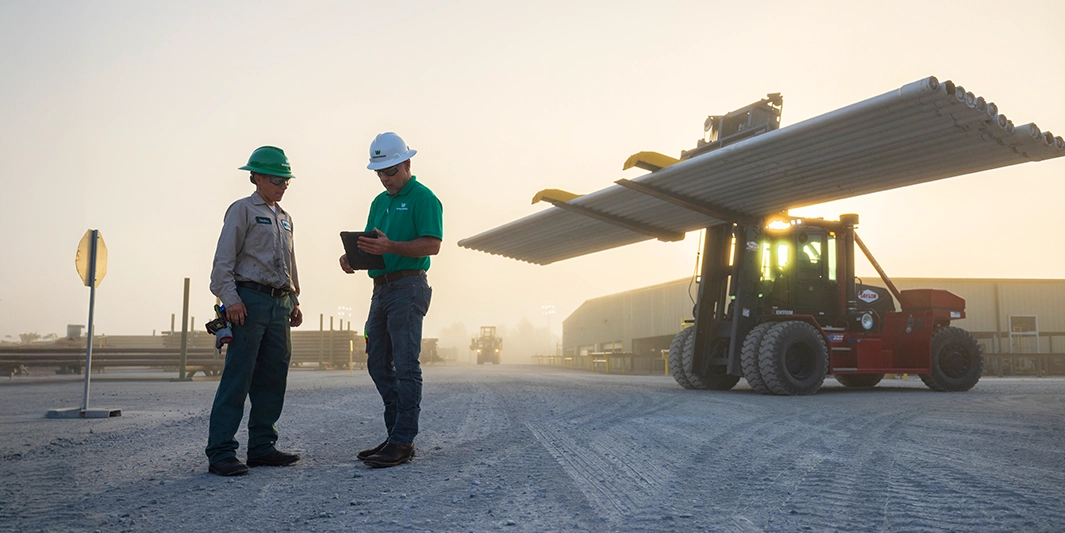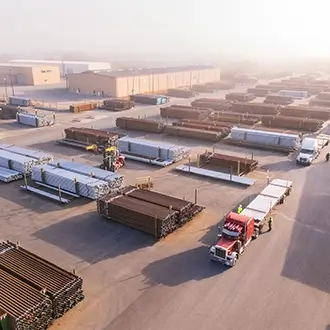
NACE Testing with Proven Internal and External Coatings
Share:
Challenge
The oil and gas industry strives to protect oilfield equipment from different operational environments for safety of both the operator and the service provider, and to improve longevity of CAPEX equipment and rental equipment. Huge strides have been made over the past 2-3 decades in equipment grades, strengths, connections, and protective coatings.
Plastic and epoxy coatings (IPC) have been applied to the internal diameter of tubing and drill pipe over this time period as a protection from corrosion. With more than 20 years of global service, NOV Tuboscope TK-34XT™ liquid epoxy coating has proven to be a very reliable product for drilling, completion, fracking, acid stimulation, and elevated temperature applications. It has been the standard for drill pipe, completion pipe, and general workstrings.
Tubular coatings for the external diameter to mitigate corrosion have been more challenging for the industry due to durability during operations, flexibility for inspection, and cost drivers. In 2015, Workstrings International introduced an external coating which has met these challenges for the industry and has saved significant cost, time, and tubular life with no operational issues for the operator and contractor.
TK-34XT™ internal coating is normally applied a single time after the pipe manufacturing process. The external coating is applied after cleaning and preparing the pipe’s outer surface. The coating is applied with an airless spray system providing a complete and uniform coverage at a desired thickness. The external coating is reapplied between deployments.
As the industry explores new areas and further develops existing fields, H2S has become a more prominent design parameter. In existing fields, where water flooding has created a mild presence of H2S, this can still pose a challenge for equipment and even for permitting the projects. Areas with increased levels of H2S or CO2 has always been very challenging for equipment, safety, as well as regulatory. The common internal coatings such as TK-34XT™ have never been declared as sour service protection since the condition is not always “new condition”. The external coating is relatively new to the industry and does not have a history in a sour environment.
The major goal when operating in a sour service environment is to control the environment so there is no, or minimal, contact of the equipment with wellbore fluids containing H2S or CO2. It is often a challenge to control the grade of all equipment in service to the level of design. High concentrations of H2S with increased exposure time will cause an issue with any grade of metal. While the internal and external coatings are not a perfect shield for the tubulars, they are a barrier, especially in a mild sour service environment, Region 1 or Region 2, where higher grade tubulars could be deployed with applied tested internal and external coatings and the environment controlled. Posed with this challenge, Workstrings took the initiative to conduct NACE testing on their standard coatings, TK-34XT™ internal coating and the proven external coating.
Tests 1 & 2
The first two tests were conducted per NACE TM0177-2016 Method A tensile test to determine the sulfide stress cracking (SSC) resistance of various steel samples coated and uncoated. The pipe manufacturer’s standard vendors for test sample preparation and NACE testing were used for this project. NACE samples were prepared from the weld area of V-150 grade pipe. The weld area can be an area of concern. These NACE test samples would include 135ksi tool joint material, 150ksi pipe material, and the weld HAZ area, approximately 120ksi yield. Solution D was chosen for Test #1 which is defined as 7% H2S and 80% stress level for 720 hours of exposure. For Test #2, Solution A with a 100% concentration of H2S and 80% stress level for 720 hours of exposure time was chosen. Test #2 also include samples with scratched TK-34XT™ to resemble wireline scrapes on IPC and abraded external coated samples to resemble worn or used coated tubulars.
Test #1 Results - 7% H2S
| Specimen | Type of Coating | Coating Condition | Temp (F) | 80% Stress Level (ksi) | Test Results | # Hours at Failure |
| 1 | Uncoated | N/A | 39 | 120.0 | Failed | 343.3 |
| 2 | Uncoated | N/A | 70 | 120.0 | Passed | N/A |
| 3 | Uncoated | Perfect | 39 | 120.0 | Passed | N/A |
| 4 | OD Coated | Abraded 6.3% | 39 | 120.0 | Passed | N/A |
| 5 | OD Coated | Perfect | 70 | 120.0 | Passed | N/A |
| 6 | OD Coated | Abraded 6.3% | 70 | 120.0 | Passed | N/A |
| 7 | TK-34XT™ | Perfect | 39 | 120.0 | Passed | N/A |
| 8 | TK-34XT™ | Scratched 3.8% | 39 | 120.0 | Passed | N/A |
| 9 | TK-34XT™ | Perfect | 70 | 120.0 | Passed | N/A |
| 10 | TK-34XT™ | Scratched 3.8% | 70 | 120.0 | Passed | N/A |
Test #3 Results S-135 MYS 7% H2S
| Specimen | Type of Coating | Coating Condition | Temp (F) | 80% Stress Level (ksi) | Test Results | # Hours at Failure |
| 11 | Uncoated (Control) | N/A | 39 | 108.0 | Passed | N/A |
| 12 | Uncoated (Control) | N/A | 70 | 108.0 | Passed | N/A |
| 13 | OD Coated | Perfect | 39 | 108.0 | Passed | N/A |
| 14 | OD Coated | Abraded 6.3% | 39 | 108.0 | Passed | N/A |
| 15 | OD Coated | Perfect | 70 | 108.0 | Passed | N/A |
| 16 | OD Coated | Abraded 6.3% | 70 | 108.0 | Failed* | 12.4* |
| 17 | TK-34XT™ | Perfect | 39 | 108.0 | Passed | N/A |
| 18 | TK-34XT™ | Scratched 3.8% | 39 | 108.0 | Passed | N/A |
| 19 | TK-34XT™ | Perfect | 70 | 108.0 | Passed | N/A |
| 20 | TK-34XT™ | Scratched 3.8% | 70 | 108.0 | Passed | N/A |
NACE Test #3 Results. S-135 Samples, Solution D (7% H2S)
* Mechanical failure caused by poor threads
| Date of Design | Vessel | HWO Unit | Type of Cleanout | TD (Designed or Actual) | ID of Pipeline |
| 13 April 2020 | Helix Q4000 | SBS Energy | Pipeline Decommission | 29,000’ Planned 28,789’ Actual | 4.775” |
| 14 May 2019 | Spar | ISS | Spar Column/Pipeline | 29,283’ Planned | 5.125” |
| 27 May 2015 | Spar | ITS | Pipeline | 21,000’ Planned | 5.410” |
| 08 April 2014 | Spar | Spar Column/Pipeline | 18,077’ | 4.000” | |
| 06 Sept 2011 | Spar | ISS | Pipeline | 20,555’ | 5.625” |
| 04 June 2010 | Spar | Export Pipeline | 21,806’ | 16.000” | |
| 28 Sept 2005 | Helix Q4000 | Pipeline | 25,000’ Planned 23,800’ Actual | 6.893” |
Test 3
For Test #3, twenty test coupon samples were evaluated: 10 coupons were S-135 MYS grade material and 10 coupons were V-150 MYS grade material. Test #3 used only the higher-grade materials for the coupon samples without the weld area; used a controlled method of damaging the coating; and tested one sample from each category at a lower temperature (4oC/39°F) equivalent to the sea floor temperature which would be a harsher environment than room temperature ~21oC/72oF.
Test #3 Results V-150 MYS 7% H2S
| Specimen | Type of Coating | Coating Condition | Temp (F) | 80% Stress Level (ksi) | Test Results | # Hours at Failure |
| 1 | Uncoated (Control) | N/A | 39 | 120.0 | Failed | 343.3 |
| 2 | Uncoated (Control) | N/A | 70 | 120.0 | Passed | N/A |
| 3 | OD Coated | Perfect | 39 | 120.0 | Passed | N/A |
| 4 | OD Coated | Abraded 6.3% | 39 | 120.0 | Passed | N/A |
| 5 | OD Coated | Perfect | 70 | 120.0 | Passed | N/A |
| 6 | OD Coated | Abraded 6.3% | 70 | 120.0 | Passed | N/A |
| 7 | TK-34XT™ | Perfect | 39 | 120.0 | Passed | N/A |
| 8 | TK-34XT™ | Scratched 3.8% | 39 | 120.0 | Passed | N/A |
| 9 | TK-34XT™ | Perfect | 70 | 120.0 | Passed | N/A |
| 10 | TK-34XT™ | Scratched 3.8% | 70 | 120.0 | Passed | N/A |
NACE Test #3 Results. V-150 Samples, Solution D (7% H2S)
Testing was performed using test Solution D 7.0% H2S. Stress level was set to 80% of minimum yield strength. Half of the coupons in each group were tested at room temperature (NACE testing is typically 21oC/72°F). The other half were tested at 4oC/39°F to simulate temperature at the sea floor. Total test time of 720 hours with elapsed failure time documented where applicable.
Test #3 Results S-135 MYS 7% H2S
| Specimen | Type of Coating | Coating Condition | Temp (F) | 80% Stress Level (ksi) | Test Results | # Hours at Failure |
| 11 | Uncoated (Control) | N/A | 39 | 108.0 | Passed | N/A |
| 12 | Uncoated (Control) | N/A | 70 | 108.0 | Passed | N/A |
| 13 | OD Coated | Perfect | 39 | 108.0 | Passed | N/A |
| 14 | OD Coated | Abraded 6.3% | 39 | 108.0 | Passed | N/A |
| 15 | OD Coated | Perfect | 70 | 108.0 | Passed | N/A |
| 16 | OD Coated | Abraded 6.3% | 70 | 108.0 | Failed* | 12.4* |
| 17 | TK-34XT™ | Perfect | 39 | 108.0 | Passed | N/A |
| 18 | TK-34XT™ | Scratched 3.8% | 39 | 108.0 | Passed | N/A |
| 19 | TK-34XT™ | Perfect | 70 | 108.0 | Passed | N/A |
| 20 | TK-34XT™ | Scratched 3.8% | 70 | 108.0 | Passed | N/A |
NACE Test #3 Results. S-135 Samples, Solution D (7% H2S)
* Mechanical failure caused by poor threads
Conclusion
This NACE testing project proved positive results for the tested coatings in that all of the proven external coating samples passed and all TK-34XT™ samples passed even when scratched or abraded*. The #3 test using coupons from higher grade material, 135ksi MYS and 150ksi MYS, and at a lower test temperature 4oC/39oF demonstrated a harsher environment and resulted in all samples passing. These results show that the coatings create a barrier between the metal and the environment. In all 3 tests, there were failures in the Uncoated Control coupons. For milder sour service environments, Region 1 and Region 2, the coatings could be beneficial for deploying higher grade tubulars for operations, especially in conditions where higher strength tubulars are required, and no sour service options are readily available. This can lower the total cost of ownership for the operator by using available tubulars with proper coating protection.
These coatings have proven themselves extremely successfully as barriers to corrosion in standard environments of salt-based fluids from seawater to heavy completion fluids with no additional chemicals. With the benefit of both the internal and external proven coatings, the NACE testing demonstrates additional benefits as a barrier when exposed to a sour service environment. When the environment is controlled by pH and scavengers, the potential for improved mitigation is increased.
Note: The coating manufacturers are not promoting these coatings as sour service products. There will always be imperfections in the coating process and imperfections due to normal handling and operations. The operator must always evaluate the risk in these environments. The testing will benefit the operator in developing the risk analysis.
*Specimen #16 failed due to poor threading and was noted by the test lab early in the test and should be disregarded.



Let’s Tackle Your Biggest Challenges
From rental tubulars to custom-engineered solutions, Workstrings redefines limitations to help you secure success in your land, offshore, or deepwater projects. Let’s discuss your needs.
